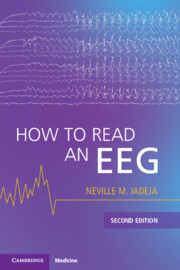Book contents
- How to Read an EEG
- Reviews
- How to Read an EEG
- Copyright page
- Dedication
- Contents
- Figure Contributions
- Foreword to the First Edition
- Preface
- How to Read This Book
- Part I Basics
- Chapter 1 Introduction
- Chapter 2 Polarity and Montages
- Chapter 3 Localization
- Chapter 4 Frequency and Rhythm
- Chapter 5 Maturation
- Chapter 6 Normal Adult EEG
- Part II Interpretation
- Part III Specific Conditions
- Appendix: How to Write a Report
- Index
- References
Chapter 3 - Localization
from Part I - Basics
Published online by Cambridge University Press: 27 September 2025
- How to Read an EEG
- Reviews
- How to Read an EEG
- Copyright page
- Dedication
- Contents
- Figure Contributions
- Foreword to the First Edition
- Preface
- How to Read This Book
- Part I Basics
- Chapter 1 Introduction
- Chapter 2 Polarity and Montages
- Chapter 3 Localization
- Chapter 4 Frequency and Rhythm
- Chapter 5 Maturation
- Chapter 6 Normal Adult EEG
- Part II Interpretation
- Part III Specific Conditions
- Appendix: How to Write a Report
- Index
- References
Summary
This chapter describes localization using bipolar and referential montages and includes the concepts of active reference and how to select a suitable reference when using referential montages. Localization is the art of locating the site of maximal potential on the cortical surface, presumably the origin of a waveform. This depends on the montage and rules of polarity. Certain regions such as sulcal depths, inferior surfaces, and very small potentials may be surface EEG negative. Bipolar montages use phase reversals and referential montages use maximum amplitude for localization. An apparent phase reversal on a referential montage suggests the possibility of a horizontal dipole or an active reference. Active reference occurs when the reference electrode lies close to the potential focus or becomes contaminated by artifact leading to false localizations. Therefore, it is important to select relatively inert electrodes as reference electrodes when using a referential montage. [145 words/844 characters]
Information
- Type
- Chapter
- Information
- How to Read an EEG , pp. 24 - 32Publisher: Cambridge University PressPrint publication year: 2025
References
Accessibility standard: WCAG 2.2 AAA
Why this information is here
This section outlines the accessibility features of this content - including support for screen readers, full keyboard navigation and high-contrast display options. This may not be relevant for you.Accessibility Information
Content Navigation
Allows you to navigate directly to chapters, sections, or non‐text items through a linked table of contents, reducing the need for extensive scrolling.
Provides an interactive index, letting you go straight to where a term or subject appears in the text without manual searching.
Reading Order & Textual Equivalents
You will encounter all content (including footnotes, captions, etc.) in a clear, sequential flow, making it easier to follow with assistive tools like screen readers.
You get concise descriptions (for images, charts, or media clips), ensuring you do not miss crucial information when visual or audio elements are not accessible.
You get more than just short alt text: you have comprehensive text equivalents, transcripts, captions, or audio descriptions for substantial non‐text content, which is especially helpful for complex visuals or multimedia.
Visual Accessibility
You will still understand key ideas or prompts without relying solely on colour, which is especially helpful if you have colour vision deficiencies.
You benefit from high‐contrast text, which improves legibility if you have low vision or if you are reading in less‐than‐ideal lighting conditions.
